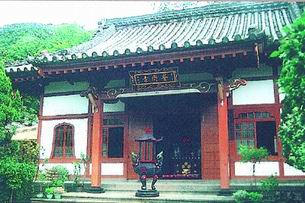Puji Temple
Puji Temple of Beitou is a rare example of a temple of the Shingon sect of Japanese Vajrayana Buddhism to be founded in Taiwan. Originally named Tiezhen Temple, it was first built in 1905 from donations by Japanese railway employees. It is dedicated to the Goddess of Mercy Avalokiteshvara, who serves as a guardian spirit of hot springs. Constructed in a Japanese style, its framework is well preserved. The main hall has a single-eaved gable-and-hip roof. Its floor plan is almost perfectly square, with both a width and a depth of three kaijian (a traditional unit of measurement equivalent to the standard width of a single room). The roof stretches forward, forming a cover for the front entrance – a popular design feature during the Edo Period in Japan. The entire temple is built of high-quality juniper. The wooden brackets and curved tie beams are decorated with elegant carvings. Of particular note are the bell-shaped windows. The main hall, the stone Avalokiteshvara image and the stele dedicated to Taiwan Railway Administration director Murakami Shoichi are all of great historical value.

![Taiwan.gov.tw [ open a new window]](/images/egov.png)
